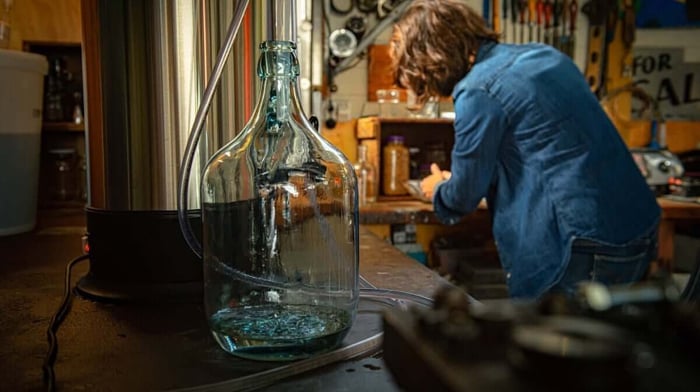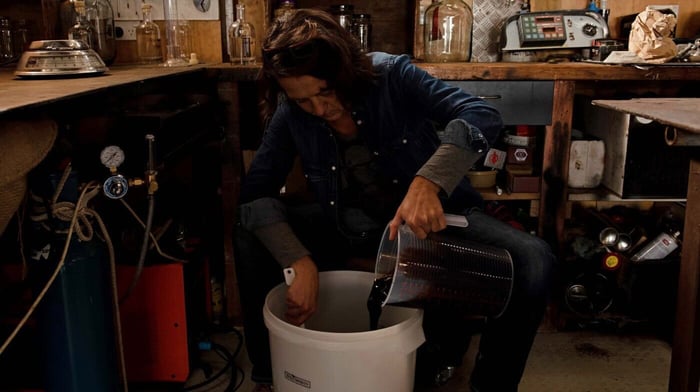Learning how to take cuts during distillation may seem like a daunting process to begin with but by following some basic steps and getting some practice, you'll be a pro in no time!
Taking cuts refers to the process where spirit is collected in small portions of similar sizes during distillation as opposed to allowing the distillate to collect in just one large vessel. This process gives you more control over the flavours and aromas that make it into your final product, allowing you to create something truly unique and to your taste.
During fermentation, many compounds are produced along with alcohol such as acetaldehyde, esters, and ethyl acetate. By taking cuts, we can minimise how many of these by-products make it into our final spirit.
Some of these by-products appear earlier on in the distillation, and others come out later or towards the end of the distillation – this depends entirely on the compound itself. Not all these by-products are bad. Some do not taste wonderful on their own, however, it can be beneficial to introduce them in small amounts to contribute different attributes to your final spirit.
Cuts are taken in blocks described as foreshots, heads, hearts, and tails.
- The foreshots are the first part of the distillate (usually 50-200 mL depending on what is being distilled) which are discarded as these can contain harmful compounds and off-flavours.
- The heads are the distillate collected immediately after the first 50-200 mL of discarded foreshots. They can contain some undesirable, but not harmful, compounds and off-flavours. Some of these are blended into your final spirit, however, most will be discarded or retained in a separate container for redistilling in future batches.
- The hearts are the middle part of a run and are the cleanest and most flavoursome part of the distillate. A minimal amount of undesirable compounds come through into the spirit. They make up the bulk of your final spirit.
- The tails are the final part of the distillation and contain some vegetal off-flavours. These are also typically discarded, however, like the heads they can also be kept in a separate container for redistilling.
When using a pot still and creating a flavourful distillate, it is common practice to run two distillation. These two distillations are known as the stripping run and spirit run.
The Stripping Run
The stripping run is done first and 'strips' the wash down to a cleaner, more concentrated low wine. This distillation is usually done hot and fast, meaning temperature control isn’t as important as the aim is to strip the wash quickly. Just be sure to take care not to run it too hot to avoid the loss of vapour from the condenser.
The purpose of a stripping run is to capture as much distillate from the wash as possible, therefore, there is no need to remove the foreshots (50-200mL) as these can be removed during the spirit run.
The Spirit Run
Once you've completed the stripping run, it is then diluted with water to 40% ABV or lower and then distilled again - this is where cuts are taken.
During this distillation run, the flow of the still should be kept slower than on the stripping run, and ideally, the voltage going to the boiler should be controlled to ensure a nice gentle boil – the Grainfather G30 is a great example of a boiler that can double as a brewing system to make Whiskey and Bourbon washes, and then control the voltage during distillation.
How to Take Cuts During Distillation
There are a few different methods to work out how to split and collect the different cuts from a spirit run, some people base it on temperature or ABV, while others evenly split the whole run and then taste and smell later. Either way can work but to simplify things, we’re going to talk through splitting the entire run.
To do this, you will need an adequate number of glass jars, preferably 300-500 mL in size, that will be able to collect the entire run – this amount will depend on how many stripping runs have been done, if it is only one, then approx. 24 x 400 mL jars should suffice. For best results, number these so you know where exactly the cut was made.
The next step is to fire up your pot still and get ready to start the process. You will need to discard the foreshots as usual. Depending on how many stripping runs you have done this could be anything from 50 to 200 mL. Once the foreshots are discarded, you can start collecting the remaining distillate into the jars.
Ensure you collect the same volume into each jar (250 mL – 300 mL is usually a good figure – you can test and adjust this to suit your still later) and then set the jar aside.
Depending on what you wish to do, and what you’re making, you can stop collecting the distillate once the ABV drops to 10% or below, although some stop it even higher. You may start to notice some more visible by-products forming in the last number of jars - this could be an oily looking substance or off-colours coming through.
We then suggest you let the jars air out for 24 hours for the more volatile aroma compounds to dissipate. This can be done by covering them with a thin type of material, such as muslin cloth, being careful it does not dip into the jars.
Now that you've taken your cuts and have allowed the jars to aerate for 24 hours, you're ready to blend them together. To find out how to do this, check out our article How to Blend Cuts.





